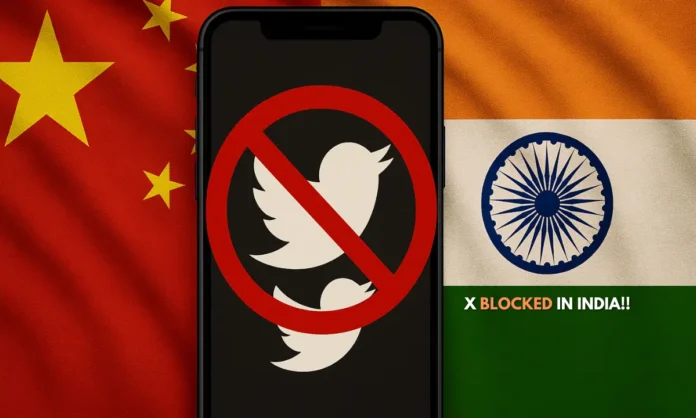Summary
- India has blocked X accounts of China’s Xinhua and Global Times over alleged pro-Pakistan propaganda.
- The action follows a diplomatic row over China renaming places in Arunachal Pradesh, intensifying tensions.
- The crackdown extends to Turkey’s TRTWorld, reflecting India’s clampdown on war-related misinformation.
Propaganda or Press? India Draws the Line with Beijing’s State Media
In a significant escalation of its media and information control strategy, India has blocked access to the X (formerly Twitter) accounts of Chinese state news agency Xinhua and nationalist tabloid Global Times. The move follows accusations that both outlets were promoting Pakistani propaganda during the recent India–Pakistan military conflict—particularly reports that falsely claimed Indian jets had been shot down.
The bans come just days after Beijing reignited the Arunachal Pradesh sovereignty dispute by releasing a fresh list of “standardised” Chinese names for territories in India’s northeast. New Delhi responded swiftly, branding the action “vain and preposterous” and reasserting that Arunachal Pradesh is an “integral and inalienable part of India.”
The clampdown extends beyond China. Turkey’s TRTWorld was also blocked in India, a decision likely tied to Ankara’s support for Pakistan during Operation Sindoor and the larger geopolitical fallout from India’s retaliation to the Pahalgam terror attack. While some media bans were later reversed—including Global Times after a legal review—the message is clear: in India’s wartime media doctrine, state-backed disinformation from foreign adversaries will not be tolerated.
Chinese Propaganda platforms Global Times & XH News blocked in India.
— Pradeep Bhandari(प्रदीप भंडारी)🇮🇳 (@pradip103) May 14, 2025
This is New Bharat under PM @narendramodi
Self confident & Protecting it's national interest! pic.twitter.com/dm9VPERHsC
Blocking the Megaphones: Media as Soft Power Weapon
- India accused China’s Global Times of pushing “disinformation” during the conflict with Pakistan.
- Reports falsely claimed an Indian fighter jet was shot down—celebrated in Chinese media.
- The Indian embassy in Beijing officially protested against the narrative being pushed by Chinese state outlets.
- Turkey’s TRTWorld was also banned amid its perceived alignment with Islamabad’s messaging.
Global Times had claimed, without credible verification, that Pakistan had downed an Indian warplane using China-made fighter jets. This narrative quickly spread across platforms, causing confusion and amplifying Islamabad’s war propaganda during the most serious cross-border hostilities in decades.
India’s embassy in Beijing issued a rare and strongly worded public statement, accusing the outlet of “pushing out disinformation.” The response wasn’t just diplomatic—it was infrastructural. Access to Global Times’ X account was blocked inside India, as was the account of Xinhua, China’s official state news agency.
This action mirrors India’s growing focus on “information sovereignty” during conflicts. With war narratives increasingly shaped on social media, disinformation—especially from hostile state actors—is being treated as a national security issue. The Ministry of Information and Broadcasting, although yet to issue a formal statement, is believed to have executed the orders under existing IT and digital surveillance frameworks.
More Than Censorship: A Borderline Battle of Worldviews
- The media bans followed China’s move to rename places in Arunachal Pradesh—India called it “vain and preposterous.”
- China responded by reasserting that Arunachal is “Zangnan” and part of Chinese territory.
- India and China’s ties remain tense since the 2020 Galwan Valley clash that left 20 Indian soldiers dead.
- The current moves reflect an emerging Indian doctrine of proactive narrative defense.
The Global Times ban wasn’t just about Pakistan—it’s part of a broader pushback against Beijing’s attempts to redefine geography through cartographic aggression. China’s “standardised names” exercise is part of its long-running attempt to claim Arunachal Pradesh, a move India views as illegal and inflammatory.
The timing of the renaming announcement—during an active military crisis between India and Pakistan—is being seen in New Delhi as deliberate provocation. In response, India has hardened its media response strategy, not just diplomatically but also digitally.
Since the deadly Galwan clashes of 2020, where 20 Indian soldiers and at least four Chinese PLA personnel died, India has steadily downgraded its tolerance for China’s soft power incursions. Whether it’s banning apps, limiting Chinese tech investments, or cutting off digital megaphones, New Delhi’s strategy is evolving into a full-spectrum containment model.
Is India Setting a Global Precedent on Info Warfare?
- India has blocked thousands of social media accounts in recent weeks for spreading conflict-related misinformation.
- Critics warn the clampdown may blur the line between curbing propaganda and press freedom.
- China’s own restrictions on foreign media and social platforms provide little room for moral equivalence.
- The real battle is over who controls the truth in a crisis—and how that power is used.
Press freedom advocates have raised alarms, pointing out that among the thousands of blocked accounts are some run by independent journalists and outlets. However, the inclusion of Chinese and Turkish state media suggests India is distinguishing between journalism and state-run influence campaigns.
Notably, X (Twitter) is banned in China. India’s critics argue that responding in kind risks legitimizing authoritarian-style censorship. Supporters counter that allowing foreign governments to spread disinformation under the guise of journalism—especially during military operations—poses a national security threat.
What’s emerging is a new global playbook: in high-stakes conflicts, information control is battlefield strategy. India appears to be among the first democracies to openly adopt this doctrine—blending digital sovereignty with geopolitical assertiveness.
Misinformation in the Line of Fire
India’s decision to block Chinese and Turkish state media is not just an act of censorship—it’s an assertion of narrative control in a geopolitical moment fraught with misinformation, territorial defiance, and proxy alignment.
As China doubles down on cartographic revisionism and Pakistan mobilizes propaganda, India is drawing a firm line: disinformation will be treated as incitement. The battle for hearts and minds is now as digital as it is territorial. And India’s latest bans suggest that in this information war, silence can sometimes be the most strategic response.


